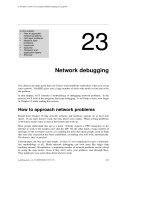Tài liệu Chapter 4: Fluid Kinematics docx
Bạn đang xem bản rút gọn của tài liệu. Xem và tải ngay bản đầy đủ của tài liệu tại đây (1.15 MB, 40 trang )
Chapter 4: Fluid Kinematics
Chapter 4: Fluid Kinematics
ESOE 505221 Fluid Mechanics 2
Overview
Fluid Kinematics deals with the motion of
fluids without necessarily considering the
forces and moments which create the
motion.
Chapter 4: Fluid Kinematics
ESOE 505221 Fluid Mechanics 3
Lagrangian Description
Two ways to describe motion are Lagrangian and Eulerian
description
Lagrangian description of fluid flow tracks the position and
velocity of individual particles. (eg. Brilliard ball on a
pooltable.)
Motion is described based upon Newton's laws.
Difficult to use for practical flow analysis.
Fluids are composed of billions of molecules.
Interaction between molecules hard to describe/model.
However, useful for specialized applications
Sprays, particles, bubble dynamics, rarefied gases.
Coupled Eulerian-Lagrangian methods.
Named after Italian mathematician Joseph Louis
Lagrange (1736-1813).
Chapter 4: Fluid Kinematics
ESOE 505221 Fluid Mechanics 4
Lagrangian Description
( )
( )
( )
0 0 0
0 0 0
0 0 0
, , ,
, , ,
, , ,
x
x
x
y
y y
z
z z
du
dx
x x x y z t
a
u
dt
dt
du
dy
y y x y z t u a
dt dt
dz du
u
a
z z x y z t
dt dt
=
=
=
= ⇒ = ⇒ =
=
=
=
Chapter 4: Fluid Kinematics
ESOE 505221 Fluid Mechanics 5
Eulerian Description
Eulerian description of fluid flow: a flow domain or control volume is
defined by which fluid flows in and out.
We define field variables which are functions of space and time.
Pressure field, P=P(x,y,z,t)
Velocity field,
Acceleration field,
These (and other) field variables define the flow field.
Well suited for formulation of initial boundary-value problems (PDE's).
Named after Swiss mathematician Leonhard Euler (1707-1783).
( ) ( ) ( )
, , , , , , , , ,V u x y z t i v x y z t j w x y z t k= + +
r
r
r r
( ) ( ) ( )
, , , , , , , , ,
x y z
a a x y z t i a x y z t j a x y z t k= + +
r
r r
r
( )
, , ,a a x y z t=
r r
( )
, , ,V V x y z t=
r r
Chapter 4: Fluid Kinematics
ESOE 505221 Fluid Mechanics 6
Example: Coupled Eulerian-Lagrangian
Method
Forensic analysis of Columbia accident: simulation of
shuttle debris trajectory using Eulerian CFD for flow field and
Lagrangian method for the debris.
Chapter 4: Fluid Kinematics
ESOE 505221 Fluid Mechanics 7
Acceleration Field
Consider a fluid particle and Newton's second law,
The acceleration of the particle is the time derivative of the
particle's velocity.
However, particle velocity at a point at any instant in time t
is the same as the fluid velocity,
To take the time derivative of, chain rule must be used.
particle particle particle
F m a=
r
r
particle
particle
dV
a
dt
=
r
r
( ) ( ) ( )
( )
, ,
particle particle particle particle
V V x t y t z t=
r r
particle particle particle
particle
dx dy dz
V dt V V V
a
t dt x dt y dt z dt
∂ ∂ ∂ ∂
= + + +
∂ ∂ ∂ ∂
r r r r
r
,t)
Chapter 4: Fluid Kinematics
ESOE 505221 Fluid Mechanics 8
Acceleration Field
Since
First term is called the local acceleration and is nonzero
only for unsteady flows.
Second term is called the advective acceleration and
accounts for the effect of the fluid particle moving to a new
location in the flow, where the velocity is different.
particle
V V V V
a u v w
t x y z
∂ ∂ ∂ ∂
= + + +
∂ ∂ ∂ ∂
r r r r
r
, ,
particle particle particle
dx dy dz
u v w
dt dt dt
= = =
Where ∂ is the partial derivative operator and d is the total
derivative operator.
Chapter 4: Fluid Kinematics
ESOE 505221 Fluid Mechanics 9
EXAMPLE: Acceleration of a Fluid
Particle through a Nozzle
Nadeen is washing her car,
using a nozzle. The nozzle is
3.90 in (0.325 ft) long, with an
inlet diameter of 0.420 in
(0.0350 ft) and an outlet
diameter of 0.182 in. The
volume flow rate through the
garden hose (and through the
nozzle) is 0.841 gal/min
(0.00187 ft3/s), and the flow
is steady. Estimate the
magnitude of the acceleration
of a fluid particle moving
down the centerline of the
nozzle.
How to apply this equation to the problem,
particle
V V V V
a u v w
t x y z
∂ ∂ ∂ ∂
= + + +
∂ ∂ ∂ ∂
r r r r
r
Chapter 4: Fluid Kinematics
ESOE 505221 Fluid Mechanics 10
Flow Visualization
Flow visualization is the
visual examination of flow-
field features.
Important for both
physical experiments and
numerical (CFD)
solutions.
Numerous methods
Streamlines and
streamtubes
Pathlines
Streaklines
Timelines
Refractive techniques
Surface flow techniques
While quantitative study of fluid
dynamics requires advanced
mathematics, much can be
learned from flow visualization
Chapter 4: Fluid Kinematics
ESOE 505221 Fluid Mechanics 11
Streamlines
A Streamline is a curve that is
everywhere tangent to the
instantaneous local velocity
vector.
Consider an arc length
must be parallel to the local
velocity vector
Geometric arguments results in
the equation for a streamline
dr dxi dyj dzk= + +
r
r r
r
dr
r
V ui vj wk= + +
r
r
r r
dr dx dy dz
V u v w
= = =
Chapter 4: Fluid Kinematics
ESOE 505221 Fluid Mechanics 12
EXAMPLE C: Streamlines in the xy
Plane—An Analytical Solution
For the same velocity field of Example
A, plot several streamlines in the right
half of the flow (x > 0) and compare to
the velocity vectors.
where C is a constant of
integration that can be set to
various values in order to plot
the streamlines.
Chapter 4: Fluid Kinematics
ESOE 505221 Fluid Mechanics 13
Streamlines
NASCAR surface pressure contours
and streamlines
Airplane surface pressure contours,
volume streamlines, and surface
streamlines
Chapter 4: Fluid Kinematics
ESOE 505221 Fluid Mechanics 14
Streamtube
A streamtube consists of a
bundle of streamlines (Both are
instantaneous quantities).
Fluid within a streamtube must
remain there and cannot cross the
boundary of the streamtube.
In an unsteady flow, the
streamline pattern may change
significantly with time.⇒ the mass
flow rate passing through any
cross-sectional slice of a given
streamtube must remain the same.
Chapter 4: Fluid Kinematics
ESOE 505221 Fluid Mechanics 15
Pathlines
A Pathline is the actual
path traveled by an
individual fluid particle
over some time period.
Same as the fluid
particle's material position
vector
Particle location at time t:
( ) ( ) ( )
( )
, ,
particle particle particle
x t y t z t
start
t
start
t
x x Vdt= +
∫
r
r r
Chapter 4: Fluid Kinematics
ESOE 505221 Fluid Mechanics 16
Pathlines
A modern experimental technique called particle
image velocimetry (PIV) utilizes (tracer) particle
pathlines to measure the velocity field over an entire
plane in a flow (Adrian, 1991).









